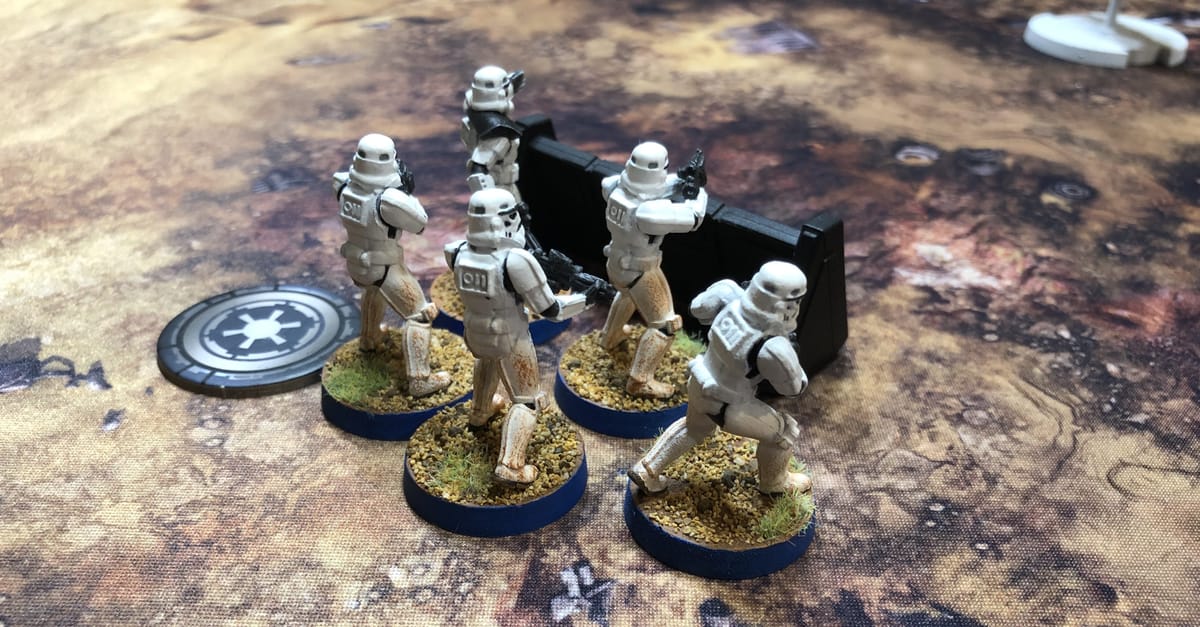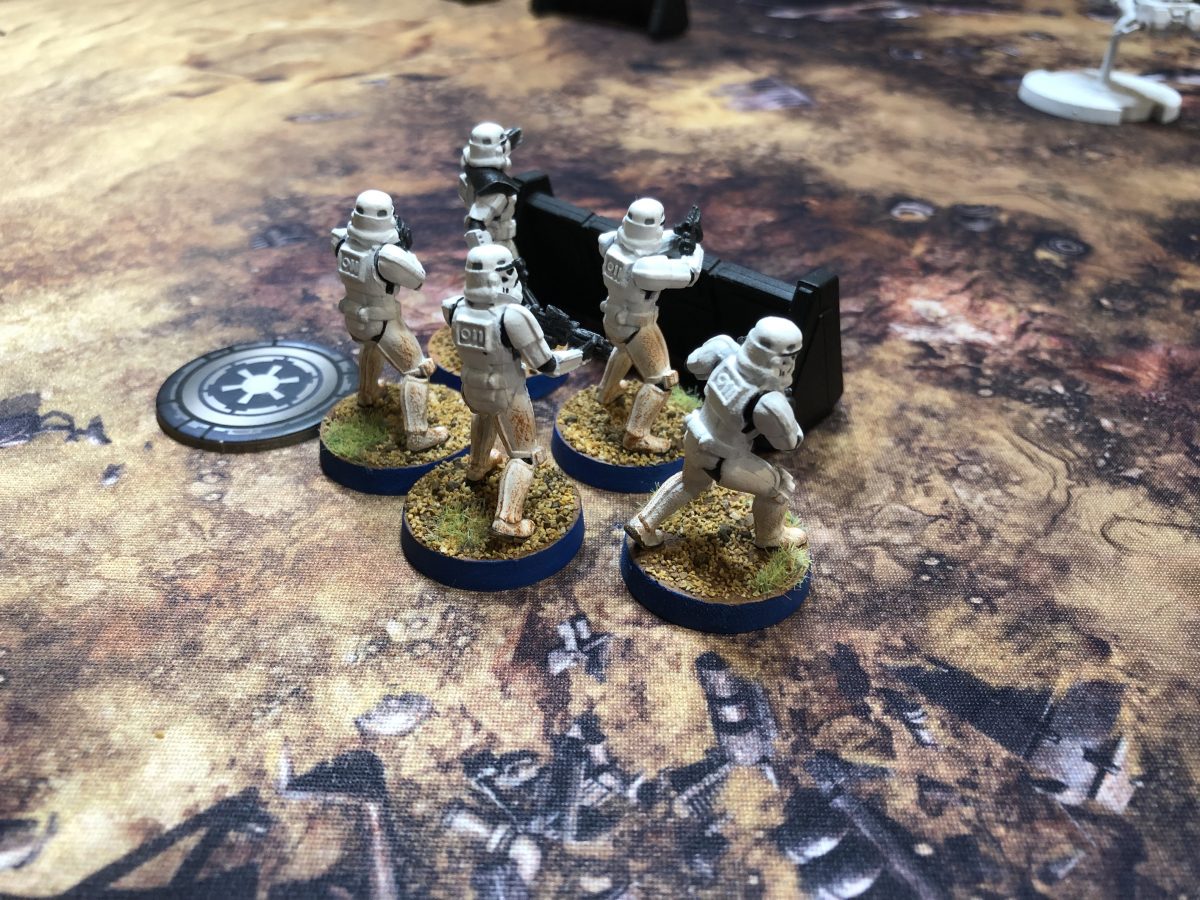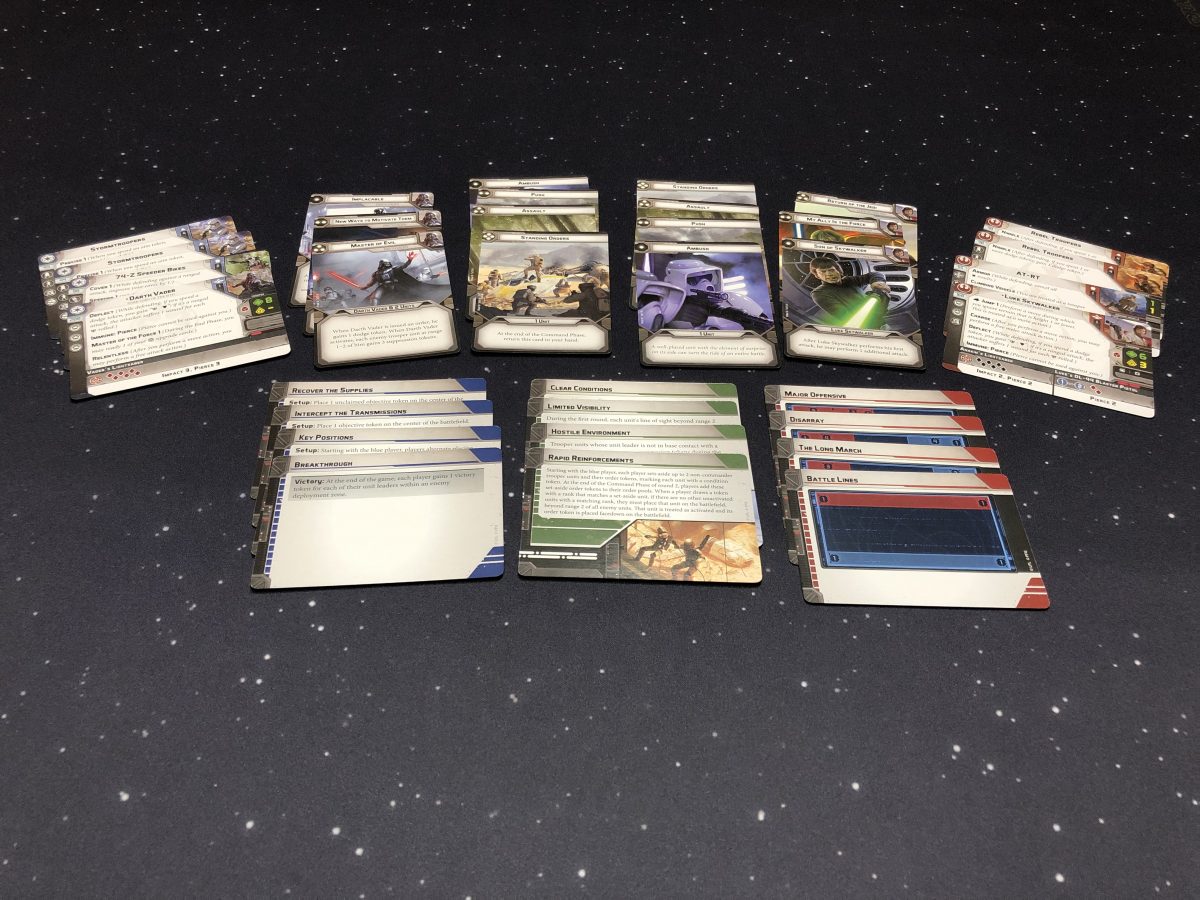
Luke Skywalker, lightsaber in hand, leads a small strike force across the desolate landscape of an alien planet. The Rebels are moving in on the objective but there is a problem: the dozen Imperial Stormtroopers led by Darth Vader that are moving to counter them. Blaster fire and grenade explosions fill the air while small walkers and speeder bikes race across the battlefield trying to flank and dislodge troops that have found good cover. Luke and Vader meet in the middle and lightsabers clash while force powers shift the tide of the battle back and forth. This is the battle so many kids imagined with their three inch-tall action figures and it is finally here in the form of a tabletop wargame. For a movie franchise that has been around as long as Star Wars, it might be surprising to some that Star Wars: Legion by Fantasy Flight Games is the first tabletop wargame to dig into ground combat in a galaxy far, far away.

The Star Wars: Legion core set has nearly everything a newcomer needs to get started with the game. Upon opening the box, the first thing you see is the Learn to Play book, artistically graced by an image of Darth Vader’s helmet. Under that is a pile of goodies including dozens of plastic pieces, dozens of cardboard tokens and dozens of cards. There are thirty-three plastic minis and eight plastic barricades. Other plastic parts include a range ruler, three movement tools and fifteen custom dice. There are dozens of tokens that help you track everything in the game. Two different sizes of cards round out the collection: playing card-sized unit, command and battle cards; and Fantasy Flight Games’ favorite half-sized cards with unit upgrades on them.
Before you can start playing the game, there are some assembly steps that must be completed. Tokens have to be punched out of a standard set of token sheets, and there is one round counter made of two cardboard pieces that must be stuck together (these are ubiquitous in Fantasy Flight Games products). The minis come unpainted and collected into tiny plastic baggies. They are ready to assemble with easy to follow instructions in the Learn to Play book. Putting these together can make set-up a multi-hour to day-long process (including a trip to the store if you do not have glue handy). The minis are excellent looking and only require a little cleaning up to eliminate unsightly mold lines and poorly fitting appendages. The three movement tools each come in two pieces that must be snapped together-caution should be taken with these; not only are the movement tools difficult to put together, but accidentally snapping parts from two different sized tools together is an easy mistake and taking them apart is not something anyone should try.

Following the Fantasy Flight Games model, the Learn to Play book is a fairly well designed primer that teaches you how to play the game. The game is easy to learn and after a quick read through of the book, you should have a basic understanding of turn order, taking actions, cover, and combat. With those concepts in mind, the book guides you into a learning battle: a scenario which pits the four Rebel units against the four Imperial units in a one-on-one fight to the death. The learning battle omits most of the more complicated rules, so about halfway through this first game (three rounds or so) most people should have a pretty good handle on how to play. The barricades provide some much needed simple terrain pieces for learning basics and there is plenty to get a handle on during the learning game, however, it is not the full game. To get the real flavor of the game, you need to add in the special abilities on the cards, kit out your units with the upgrade cards and fill up the battlefield with terrain and dig into a scenario driven fight with all the bells and whistles.
For the most part, gameplay is streamlined and fast. The game is broken down into six rounds, each round consisting of players alternating unit activations. At the beginning of each game round, players decide on a command card for that round which not only helps determine which player will get to activate first that round, but allows the player to identify specific units to activate when they choose; the remaining units are activated randomly. When a unit activates, it may perform two actions, such as moving, attacking, taking an aim token, etc. The alternating activations mean that no one player will have the advantage of moving their whole side at once, but it also means that, depending on the situation on the battlefield, moving first or last can be the difference between losing a flanked unit or not making it to an objective in time. Attacking and defending is straight forward. Because both attack and defense use the custom dice provided, players will be forced to roll dice then pick up a few of the dice and roll for the remaining required results. Three of each type is just not enough.

Moving is governed by the use of one of the three movement tools, representing the three different movement speeds in the game. Each unit uses a tool of a specific length, but you can use a shorter one if you want. The movement tools bend in the middle, forcing you to map out the unit’s movement in a fairly prescribed route. Vehicles and ground troops move differently and once terrain and key words are brought into the picture, things can get pretty complicated, despite the simple movement tools. Moving is the only action a unit can execute twice in an activation, so if you need to get across the battlefield quickly, you can do so, but you will not be able to do anything when you get there – you will have to wait until that unit’s next activation.
The game includes a handful of other concepts that add depth and complexity to gameplay. There is a balance between complexity for realism and abstraction for ease of gameplay. On the abstract side there is tool-based movement, on the complex side there is a line-of-sight targeting system that requires multiple steps to determine who can shoot at whom with which weapons and how hard the targets are to hit. There is a system for suppression that impacts the way units operate. Extra abilities of various units and upgrade cards impact how they interact with the rules and add layers of complication. Terrain adds a third dimension to the battlefield necessitating climbing rules that may take a few read throughs to understand. Each game also starts with a mini-game that has the players selecting a starting deployment, a persistent environmental condition that affects gameplay, and objectives for the game that add variety and complication to the game. Overall, the game will reward repeat plays and each time you play you will discover new tactics and strategies.
This game really brings the Star Wars universe to life. The minis are of excellent quality and look great on the table. As you gain a familiarity with the rules and your units, you will see nuances in how they work best on the battlefield which in turn opens strategies and tactics that change the way you approach the game. Just a few plays will have you thinking about how best to use your commander with your other units to gain advantage on the battlefield. After experimenting with the contents of the core set for a short time, you will be able to decide if you prefer Empire or Rebel Alliance and start expanding the units in your collection with purchases from Fantasy Flight Games’ growing line up of expansions. Unlike other wargames, Star Wars: Legion is pretty much stuck to two factions by the limitations of the Star Wars universe. Fantasy Flight Games had success adding a third faction with the Scum and Villainy additions and some pseudo factions with the New Order and Resistance, but it remains to be seen if Star Wars: Legion will follow the same path. Having Luke and Vader in the core set and other main characters from the movies and books in expansions as choices for your army is greatly satisfying. It is much nicer to field an army with Luke Skywalker at the head rather than a generic rebel commander.

It is clear that Fantasy Flight Games’ aim is to make this wargame as accessible to everyone as possible. The movement templates are the most obvious effort to simplify things. It does not get much easier than handing a player a stick that bends in one place and telling them that is the only way their mini can move. If a player is coming from a board game background, having a tight structure like that can ease the transition from square, hex, or tile-based movement. But for an experienced wargamer it will most likely seem restrictive. Combat is fairly basic for a wargame too, with just a few die rolls and easy reference to the cards a fight is resolved. Rolling only a few dice is fast, but unlike wargames that have the players rolling fistfuls of dice, luck can make one exchange of shots pretty brutal. The third major simplification is list building (creating an army using expansion units bought separately). Here, Fantasy Flight Games follows the model they established in Star Wars: X-Wing. Each unit comes with a certain number of expansions and add-ons that are card driven – if you happen to own a card that matches what your unit can take and you like it you can throw it on the pile. All of the cards you add to the pile increase your point total until you reach the cap. The core box comes with plenty of stuff to start you on this path, but ultimately, if you decide to play the game to its fullest potential, you are going to have to buy more minis and probably more dice, some may consider a second core box just because the price point for the amount of components cannot be beat.
Looking at gameplay alone, Star Wars: Legion is impressive (most impressive). But for a wargame, gameplay is only half the fun (or work depending on your point of view). All the minis in the game come unassembled and unpainted. Just like with the rules, Fantasy Flight has lowered the barrier of entry for the miniatures as well, with no requirement to clip tiny parts off of sprues or need to decide which of six heads you will use on the mini you are assembling (just occasional weapons choices). You will need to decide if you are going to paint your minis and how you are going to adorn the battlefield with terrain: Will it be a few books and some household objects, or will you buy or even build some little buildings, boulders, and so on? The model building and painting hobby that is built into wargaming is not required, but fielding painted minis on a battlefield with painted buildings is a much more immersive experience. On a side note, many of the minis (especially the Stormtroopers), are easier to paint before you glue the arms in place, so you may consider holding off on gluing the arms on when you jump into your first games so you can go back and paint them easier. Once you start down the painting path, it can delay getting models to the table, depending on how you feel about unpainted minis on the table next to painted ones.
Star Wars: Legion
Great
Star Wars: Legion is a wargame worth playing and the Star Wars fight you always imagined as a kid. The rules are easy to learn and keep in mind while playing. Novice wargamers should not be overwhelmed, but seasoned wargamers will find enough depth. Even though a few concepts (especially movement) are a bit underwhelming, this game evokes ground combat in the Star Wars universe in a new and interesting way that will keep you coming back.
Pros
- Easy to learn and play (for a wargame).
- Excellent minis that immerse you in the Star Wars universe.
- Enough complexity to reward repeat plays.
Cons
- Movement tools are awkward and clunky.
- Core set box is not enough of either faction to support game play as intended.
- Hobby aspect can slow down getting the game to the table.
